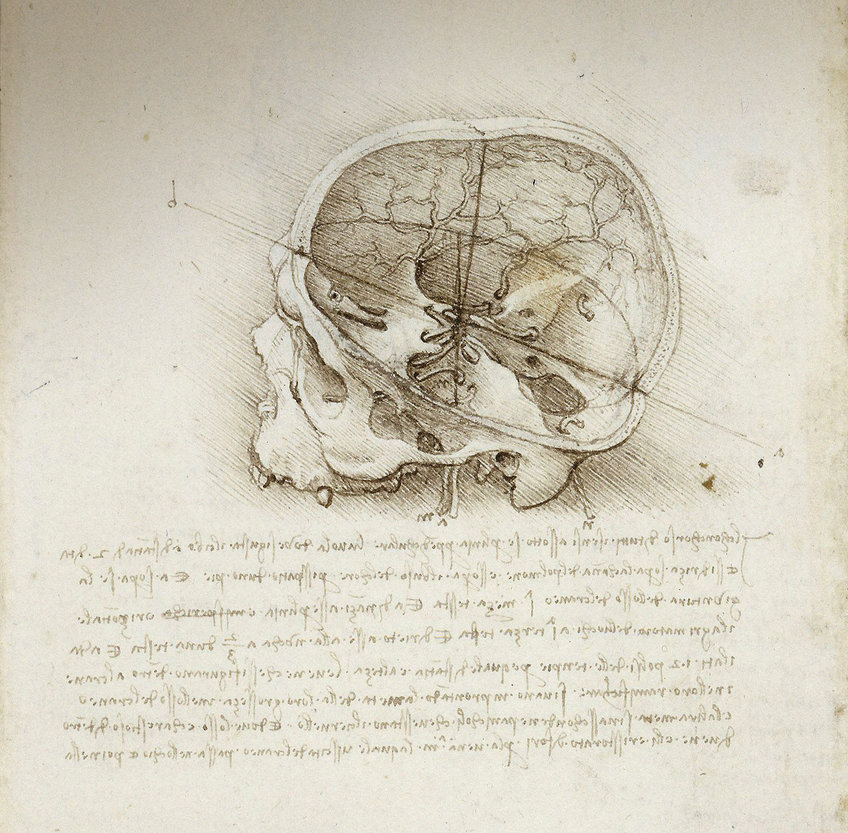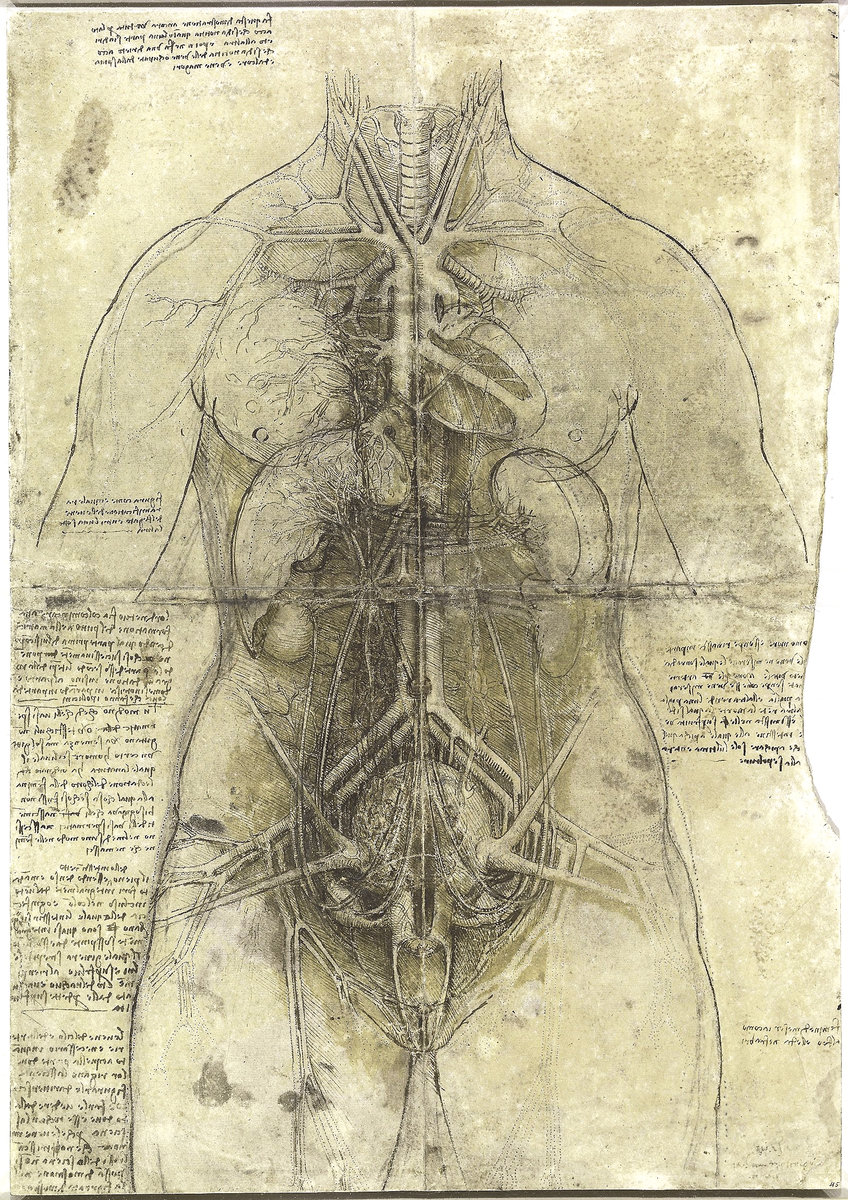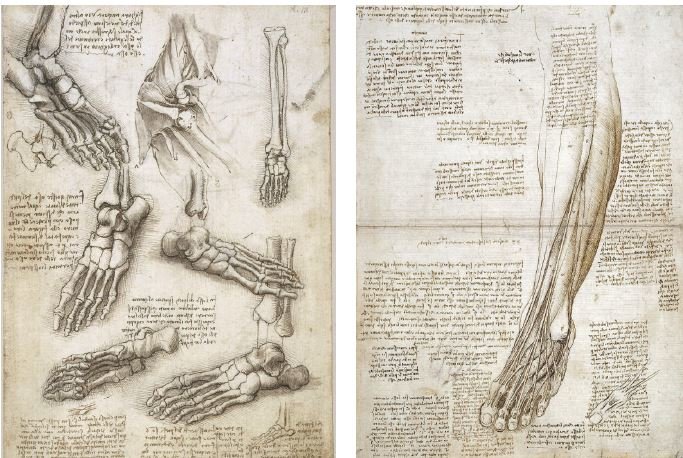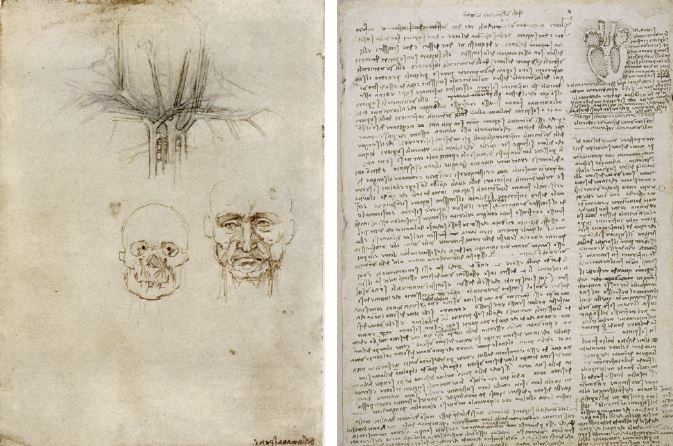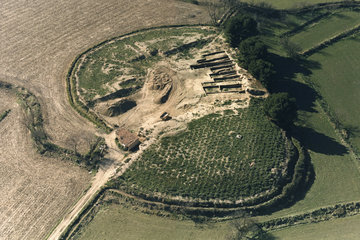The body according to Leonardo da Vinci
In an age of modern anatomy atlases and freely available online body-browsers, Leonardo da Vinci’s drawings of organs and body parts done with quill, ink and red chalk may strike us as aesthetically pleasing, yet antiquated. Nevertheless, almost everyone in Germany carries a reproduction of his famous Vitruvian Man with them – on their health insurance card. Alessandro Nova, Director at the Kunsthistorisches Institut in Florenz, on the other hand, explores Leonardo’s work in the light of the scientific knowledge it generates.
Text: Guido Hinterkeuser

Anyone who examines Leonardo da Vinci’s anatomical drawings will probably first ask themselves to what extent the detailed studies correlate to today’s state of medical knowledge. The depictions seem all too familiar, hardly deviating from the way we see things today.
Yet it is important to note that Leonardo was a pioneer in this area and wasn’t able to refer to anything even approximating such graphic visualizations of the inner workings of the human body. Medical-historical research has already extensively compared the knowledge that Leonardo garnered in his day with that of today’s anatomical information, just as his specific morphological and physiological discoveries have long been fully appreciated. The extensive inventory of drawings has also been philologically classified and sub-divided into anatomical units such as skeletal system, musculature, nervous system and circulatory system, as well as into today’s established systems, which had not yet been identified in Leonardo’s day. In short, it can be said that the anatomical studies have since been well researched.
But perhaps it was just that that motivated Alessandro Nova, Director at the Kunsthistorisches Institut in Florenz since 2006, to take a fresh look at the drawings, not so much by examining their results, but by pursuing the question of what role the process of drawing, the genuine artistic act, played in the generation of scientific knowledge.
Veiled in the shadow of ignorance

Giorgio Vasari (1511 to 1574), who paid tribute to numerous Renaissance artists with comprehensive biographies, also turned his attention to Leonardo’s anatomical studies and shed light on his association with the physician and anatomy professor Marcantonio della Torre (1481 to 1511). According to Vasari, “he was one of the first that began to illustrate the problems of medicine with the doctrine of Galen, and to throw true light on anatomy, which up to that time had been veiled in the thick and gross shadow of ignorance. And in this he found marvelous aid in the brain, work and hand of Leonardo, who made a sketchbook with drawings in red chalk retouched in pen and ink: the bodies that he dissected with his own hand were drawn with the greatest diligence.”
Leonardo was at the height of his anatomical research when he met della Torre in Pavia around 1510. The artist had turned his attention to anatomy as early as 1487 in Milan – something that would occupy him for the rest of his life. In the beginning, his investigations into traditional medical knowledge played an important role, at least as far as he was able to tap into such information. After all, it must be borne in mind that Leonardo was self-taught in this area, and could read neither Latin nor Greek. In his day, he was considered to be a man without a classical education, which made it much more difficult for him to gain access to the academic world.
This was especially the case with the work of Galen of Pergamon (129 to 199 A.D.), whose doctrines went unchallenged back then. It has been proven that Leonardo’s library contained a copy of Johannes de Ketham’s Fasciculus Medicinae, whose illustrations could at least visually con-vey Galen’s teachings before an Italian edition was published in 1495. When Leonardo carried out his first corpse dissections, his goal was to understand and verify the centuries-old views of the Greek anatomist and physician; however, his meticulous autopsies brought him increasingly into conflict with this handed-down knowledge. A challenging situation arose, which from then on would also be reflected in Leonardo’s drawings. The contradictions he encountered spurred him on to create his own illustrated work that could record his observations and that was ultimately intended to convey no less than a new understanding of the human body.
Virtuosity with chalk, pen and silverpoint

Leonardo’s encounter with della Torre twenty years later was an important experience for both of them. Leonardo benefited from the exchange with a scientist who had a command of the terminology and rules of the field. Della Torre, on the other hand, was able to make good use of the artist’s extraordinary skills as a draftsman. “However, it would be incorrect to reduce Leonardo’s role to that of an artist who simply placed his eye and hand at della Torre’s disposal,” says Alessandro Nova, whose research picks up here. For, although none of Leonardo’s contemporaries was as adept at drawing with a pen and silverpoint or with black and red chalk as Leonardo was, his anatomical works are anything but an exact mimetic recording of the reality that would have presented itself to anyone who took a close look at the dissected corpses. “Their graphic clarity stems, rather, from an enormous intellectual capacity that previously systematized and grasped that which he observed,” emphasizes Nova. “I call this a ‘manipulation of the visual data’ or the ‘constructed view’. Leonardo masterfully interwove various techniques with each other, such as the assembling of sever-al views to form a new image, the magnification, separation or dismantling of details, and the simplification or fragmentation of physicality to the benefit of a transparent figure.”
Leonardo’s drawing of the female organs, for instance, which he completed shortly before his encounter with della Torre, is an ingenious construction that, although it would never be found in reality, nevertheless conveys an image of the morphology and functioning of the female body in a precision that had not existed until then. Leonardo gave due consideration to the graphic figurative modes: while he drew the uterus as transparent, he depicted the windpipe three-dimensionally and fully formed. In contrast, he rendered the heart in a sectional view, and the digestive organs, like the stomach and intestine, he left out completely in favor of a clearer arrangement. This example clearly shows – and this holds true for most of Leonardo’s anatomical drawings – that they are stylized representations and that it is their high degree of abstraction that ensures their compelling readability to this day.
Clarity through the art of omission
In order to illustrate the musculature of the foot and lower leg, Leonardo also made use of the art of omission and simply extracted the entire skeleton, as this would have obscured the structure and organization of the muscles and tendons. By disassembling the spine into its individual parts, he graphically illustrated their structure, which would otherwise have had to be explained at great length. To this end, he enlarged certain bones disproportionately to emphasize their particular functionality; with others, he considered it necessary to show them from various perspectives to facilitate understanding from all sides. “Leonardo himself explained: ‘Through this tersest way of drawing from various perspectives, one provides full and true knowledge of them,’” says Alessandro Nova, quoting the artist and scholar.
This methodical understanding can already be seen in Leonardo’s early anatomical drawings, like the skull studies from 1489. Only the combination of depictions from different perspectives, for example the orthogonal projection and the top view, can provide the viewer with a comprehensive and informative image of the inner workings of the skull. The drawing is thus not a portrayal of the skull, but a symbol that can’t be seen in this form in reality. Furthermore, Nova can convincingly attest to the model-like character of such an assembly by comparing Leonardo’s sectional drawings of the central structure of a domed church: “He adapted the methods of depiction that he was familiar with from his work as an artist for his anatomical studies.”
In the company of quartered corpses

Incidentally, in a new preface to his anatomy treatise in 1509, Leonardo listed what he considered to be the necessary requirements for modern anatomical drawings. “In the process, he explicitly points out that it requires much more than expert draftsmanship,” says Nova with a grin, in light of Leonardo’s apparent foresight, and goes on to quote Leonardo’s words: “But though possessed of an interest in the subject, you may perhaps be deterred by natural repugnance, or if this does not restrain you, then perhaps by the fear of passing the night hours in the company of these corpses, quartered and flayed, and horrible to behold. And if this does not deter you, then perhaps you may lack the skill in drawing essential for such representation, and even if you possess this skill it may not be combined with a knowledge of perspective, while if it is so combined you may not be versed in the methods of geometrical demonstration, or the methods of estimating the forces and power of the muscles; or you may perhaps be found wanting in patience so that you will not be diligent.”
Drawing is a cognitive act for Leonardo

Leonardo thus deliberately edited his drawings and constantly worked on improving the forms of representation. As a natural scientist, he penetrated the surface of the body, delving into the interior while dissecting it. As an artist, through the medium of diagrams, he again returned to the body as a whole, which he pieced together anew from the information he considered important. His drawing features a density of information that could never have been gleaned from a single autopsy. Only several dissections finally generated the “data” that flowed into a collective representation and yielded the overall image. As a result, by pondering over the way to arrive at the best depiction, Leonardo simultaneously attained a deeper understanding of the object. “As such, for him, drawing is not a reproductive, but a cognitive act,” explains Hana Gründler, who is working with Alessandro Nova on this project. “In his drawings, Leonardo doesn’t simply represent “fixed” knowledge. It is rather the act of drawing itself that sets free renewed reflec-tions about what is being drawn. This, in turn, leads to a modified view of the research object.” Gründler continues: “The processuality in the acquisition and generation of knowledge also becomes visible in the numerous correc-tions and improvements that have been identified in the drawings.”
New observations versus ancient knowledge
Of course, Leonardo’s research began with nature studies, which are what gave him cause time and again to un-dertake the complex efforts required for performing autopsies, whether in Milan, Florence or Rome. Through empirical studies, he succeeded in revising traditional scientific representations, and a brief look at the illustrations in Ketham’s book is all it takes to appreciate the progress in Leonardo’s drawings, which denote a new epoch in the history of the depiction of the human body. “However, on occasion, he didn’t completely break with tradition,” stresses Nova, citing the studies in which Leonardo and della Torre turned their attention to the heart and its ventricles. While, on the one hand, they made the pioneering discovery that the heart’s system included four – and not just two – ventricles, on the other hand, Leonardo’s drawings of this, which recorded their discovery, depicted the heart’s septum as porous and permeable for blood, which he could not have observed on an exposed heart. “He could only have taken the hypothetical existence of these pores between the ventricles from the literature of the times. The precision of new observations here still collides with the fictions of conventional knowledge as it was imparted in Galen’s teachings,” con-cludes Nova.
A mere footnote in the history of medicine
Although the drawings are at the heart of Nova’s research, they can’t be fully understood and analyzed without the accompanying texts that Leonardo added in his famous mirror writing. Text and image form an inseparable whole. From a very early stage, Leonardo planned to publish the results of his dis-sections in a richly illustrated work with the title De figura umana – “of course, it’s a pity that, as with so many of the projects in his life, he was ultimately unable to bring this undertaking to completion,” Nova finds. This is why there is only the occasional reference to Leonardo in today’s history of science and medicine. Only the written elucidations make it possible to explain functional correlations and communicate the primary morphological observation from a physiological perspective.
Findings drawn up in dialog form
To this end, over the decades, Leonardo even altered the concept of his treatise. While, in 1489, he assumed there would be a tight, balanced synthesis of words and images, in which, however, the drawings would ultimately have predominated, he decided, starting in 1509, to draw up the results in dialog form, which was standard for many written works during the Italian Renaissance, and which could better express doubts, opinions and unresolved issues. Leonardo came to recognize that one could limit oneself to the medium of drawing only “if it were possible to observe all of the things that are depicted in these drawings in a single figure. But it is better to render and describe.”
“In the end, it was another physician who profited from Leonardo’s achievements,” says Alessandro Nova. “It was Flemish anatomist Andreas Vesalius who, in 1543, was the first to publish an illustrated anatomical work based on dissections of the body: the compendium De humani corporis fabrica. But it is believed that he may have known Leonardo’s drawings.”
The anatomical subject matter and the comprehensive accompanying texts go beyond what an art historian usually deals with, making an interdisciplinary approach virtually inescapable. In 2008, a conference was held in Florence that brought together physi-cians and science historians, philologists and linguists, and last but not least, art historians. The results were published in 2011 in a collection of essays entitled Leonardo da Vinci’s Anatomical World. Language, Context and ‘Disegno’. In this publication, Leonardo’s language is examined and light shed upon the philosophical and literary works that he dealt with and that influenced his texts. It may come as a surprise that, up until that point, and despite the immense body of literature about the life and work of Leonardo, no one had ever turned their attention to the books and treatises written by della Torre, even though he was, for a short time, working in such close collaboration with Leonardo.
The search for the seat of the soul
As the study of the human body was far more than an empirical-scientific project for Leonardo, the metaphysical aspects can’t be overlooked. “While I thought I was learning how to live, I have been learning how to die,” he once philosophized, and it comes as no surprise that the search for the seat of the intellect, the soul and the emotions repeatedly accompanies his anatomical studies. The encounter with a 100-year-old man in Florence around 1507/1508 with whom Leonardo spoke shortly before the man’s death and whose body he then dissected induced him to look for traces of dying in the specific anatomy of the deceased. Since, in those days, the process of dying was particularly associated with agony and suffering, the tranquil passing away of the old man had strongly impressed Leonardo.
In the meantime, Alessandro Nova has also begun to turn to other scientific areas in his exploration of Leonardo’s drawings. To this end, he invited young scholar Rodolfo Maffeis to join him in conducting research into Leonardo’s studies concerning light and astronomy. In contrast to the anatomical drawings, the astronomical sketches haven’t been historically-philologically examined, meaning that they must first be classified and embedded in the knowledge context of the time. Moreover, 2011 and 2013 saw two further conferences devoted to Leonardo’s optical studies and to his concept of nature. “When it comes to optics, we also encounter the typical triad: appropriation of traditional knowledge, contraposition of his own experiments and observations, and recording of the results in texts, sketches and drawings,” says Nova, reporting on the first results. As with anatomy, optics preoccupied Leonardo his entire life, so that it isn’t far afield to interpret his meticulous scientific studies as a permanent subtext to his artistic accomplishments.
Or did they even constitute the main text? The further exploration of the interrelationship between art and science, which, in the past, were very closely tied to each other, could offer vital impulses to research into Leonardo da Vinci. Thanks to Alessandro Nova, this interrelationship has finally found a bastion at the Kunsthistorisches Institut in Florenz.
Note: The article was first published in MaxPlanckResearch 3/2013.
